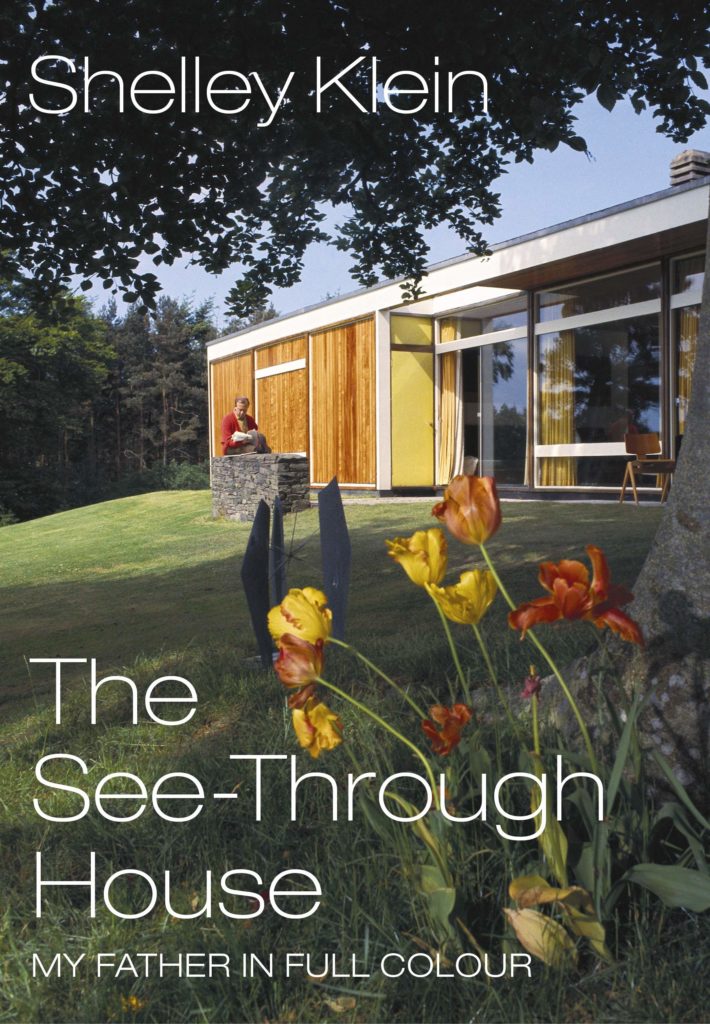Clare Wadd looks over Shelley Klein’s ‘The See-Through House: My Father in Full Colour’ – a document of growing up in a modernist, open-plan house as the daughter of a pioneering textile designer.

What a curious book this is, about loss and grief and architecture and textiles and colour and design. Subtitled ‘My Father in Full Colour’, it’s also the story of a father-daughter relationship, both with each other and with the family home.
Shelley Klein and her siblings grew up in a unique 50s modernist open-plan house, High Sunderland in the Scottish Borders, that’s made of coloured glass and wood panels and set on its own in the woods. It was designed for her father by Peter Womersley who lived nearby and was a fixture in her childhood. After her mother’s death she moved back to look after her by then elderly father.
Her father was Bernat (Beri) Klein, a textile designer and painter fascinated and inspired by the colours in the region. The book contains some beautiful sentences describing the landscapes that inspired her father’s work: ‘Everything comes light with sunshine and mud and the mesmerising green drift of this riveryness’. Her mother Peggy designed knitwear using his textiles and ran the mill where the fabrics were made. They sold to the likes of Marks and Spencer, but also to Chanel, Dior etc, meaning high-end fashion shoots and shows were held in their modernist living room.
The See-Through House is laid out in rooms, with a floorplan of the house to aid navigation. Except in the master bedroom and bathrooms, you can see everywhere from everywhere else, and Shelley wonders if this makes her secretive – but maybe it’s just an unfair way for her father, a man so comfortable in his own skin he walks round naked in his see-thorough house, to make others live? Dialogue, much of it presumably reimagined, between Shelley and her father – sometimes current, sometimes teenage – is interspersed through the book. She tacks a photo to her bedroom wall, but has to put it up in a cupboard instead; wears, horror of horrors, a Laura Ashley dress; slings her coat over a designer chair – then, even worse, sits on it – but it’s not for sitting on, it’s for looking perfect.
After the textiles business folds in the eighties recession, her mother ends up running what sounds like a knick-knacks shop, about as far removed from the design perfection of the house as possible; she has a box of crystal-cut sherry glasses hidden at the back of her wardrobe because she loves them but they can’t be allowed to sully their surroundings.
Her father was a single-minded absolutist – “gardening” involves scrubbing the bark of the silver birches surrounding the house with bleach (the naturalist in me is screaming) to get rid of the lichen because the birches were planted to reflect the white columns of the house and ‘all this green stuff is spoiling them’. It’s meant to be funny of course, and it is, but at the same time Klein worships her father and sort of accepts his obsession in a way that one can’t imagine him accepting anyone else’s. No compromise in this house – when she moves back “home”, she brings her furniture but has to hide it away in her room, and he can’t understand why she won’t sit on his specially designed uncomfortable but perfect-looking sofas in the main living room instead of on her own comfortable chairs.
Though I struggled with it a little — I couldn’t quite visualise the house, despite the floor-plan and photos, and I couldn’t really like the man it was built for — The See-Through House is nonetheless complex and funny, and will no doubt resonate with devotees of modernist architecture.
*
The See-Through House is out now, published by Chatto & Windus and priced £16.99. You can order a copy from your local independent bookshop.